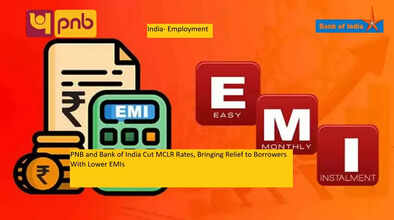PNB and Bank of India Cut MCLR Rates, Bringing Relief to Borrowers With Lower EMIs

Punjab National Bank (PNB) and Bank of India (BoI) have announced a significant relief for borrowers by reducing their Marginal Cost of Funds-based Lending Rates (MCLR). This move, effective from September 1, 2025, will lower the Equated Monthly Installments (EMIs) on home, personal, and auto loans.
The decision comes even though the Reserve Bank of India (RBI) kept the repo rate unchanged at 5.5% during its Monetary Policy Committee (MPC) meeting on August 6, 2025. RBI maintained a cautious stance in the wake of global uncertainties, particularly after tariff hikes in the US. While the central bank refrained from altering policy rates, banks have taken proactive steps to reduce lending costs for their customers.
PNB Reduces MCLR by Up to 15 Basis Points
PNB revised its MCLR across multiple tenures, offering direct relief to borrowers. The new rates are:
-
Overnight MCLR: Reduced from 8.15% to 8.00%
-
One-month MCLR: Reduced from 8.30% to 8.25%
-
Three-month MCLR: Reduced from 8.50% to 8.45%
-
Six-month MCLR: Reduced from 8.70% to 8.65%
-
One-year MCLR: Reduced from 8.85% to 8.80%
-
Three-year MCLR: Reduced from 9.15% to 9.10%
This revision means borrowers with floating-rate loans linked to MCLR could see their EMIs fall in the coming months, easing financial pressure amid rising household expenses.
Bank of India Also Announces Rate Cuts
Bank of India followed suit by reducing MCLR across most tenures, except the overnight rate. The cut ranges between 5 and 15 basis points, with the updated rates also coming into effect from September 1, 2025.
What is MCLR and Why Does It Matter?
MCLR, or the Marginal Cost of Funds-based Lending Rate, is a benchmark interest rate used by banks to determine lending rates for loans like housing, personal, and automobile loans under the floating-rate system. A reduction in MCLR directly impacts EMIs, providing relief to existing borrowers.
However, it is important to note that new retail loans are now largely linked to the External Benchmark Lending Rate (EBLR), as mandated by the RBI. While older loans continue under the MCLR system, borrowers are often given the option to switch from MCLR to EBLR-based loans for better transparency and quicker transmission of policy rate changes.
MCLR vs. EBLR: Key Difference
-
MCLR: Applied to older floating-rate loans, where changes in the benchmark rate influence EMI amounts.
-
EBLR: A newer system linking loan rates directly to external benchmarks such as the repo rate, government securities yield, or treasury bill rates, ensuring faster transmission of RBI policy changes.
With these latest reductions, PNB and BoI have taken a customer-friendly approach, providing some cushion to households managing loan repayments. The move is expected to boost credit demand in housing, auto, and personal loan segments while also easing the financial burden on millions of borrowers.

